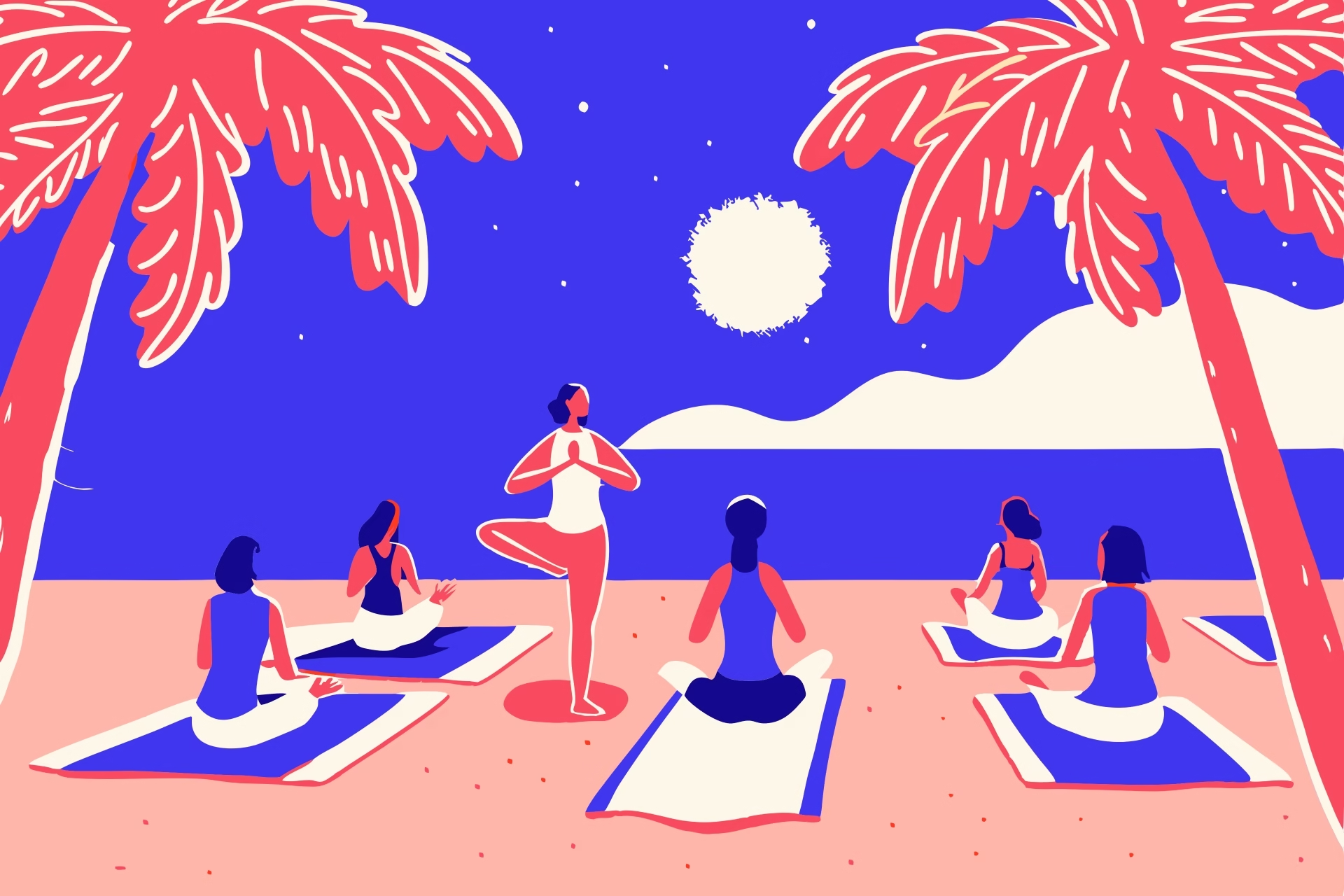Is wellness just another productivity game now?
Something strange has happened in modern wellness culture. We now “optimize” self-care, schedule relaxation, and track mindfulness. What was meant to be a counterbalance to hustle culture has become… well, another form of hustle.
Slow living isn’t about doing less for the sake of it—it’s about questioning why we do what we do.
What if the real secret to well-being isn’t another productivity hack, but learning to live with more presence and intention?
As wellness organizers, you have a powerful opportunity to introduce a slow living-inspired wellness program that truly transforms lives.
There are a variety of approaches to this way of living, but the common goal is to remove the excess, stay organized, and create a more intentional, present lifestyle—a concept that aligns perfectly with the wellness industry.
Don’t get so busy making a living that you forget to make a life.” – Dolly Parton
If you want to help your clients achieve lasting well-being, reduced stress, and deeper self-awareness, integrating slow living practices into your programs is the way forward.
Here is our guide to designing a slow living wellness program that not only stands out in the market but also fosters a more mindful, fulfilling life for your clients.
What is Slow Living and Why Should It Be Part of Your Wellness Program?

Slow living isn’t about doing things at a snail’s pace—it’s about doing things with purpose and presence.
Slowness isn’t about inefficiency. It’s about deep engagement. Research in behavioral psychology suggests that intensity isn’t what leads to lasting habit formation—sustainability is.
People are more likely to maintain wellness habits when they feel enjoyable, not forced.
So what does this mean for your wellness program?
- Less multitasking, more immersion: Design sessions that allow full participation without distraction.
- Build in unstructured time: Let clients reflect, breathe, and process rather than rushing to the next agenda item.
- Encourage curiosity, not perfection: Invite clients to explore their well-being, rather than simply following a preset formula.
The question is—how do you incorporate slow living principles into your program without compromising engagement or results?
Assessing Your Current Wellness Program: Are You Moving Too Fast?

Let’s pause for a moment—because even the most well-intentioned wellness programs can accidentally slip into hustle mode. Before you tweak your offerings or add more to your plate, try this: take a “wellness speed audit.”
Ask yourself:
- Are my clients feeling like they have to constantly track, measure, or perform to feel “well”?
- Are my sessions packed so tightly that participants leave drained instead of grounded?
These are subtle signs that your program might be encouraging doing over being—and that it’s time to slow things down.
The most effective wellness programs don’t force transformation. They create space for it to unfold—intentionally, sustainably, and with deep respect for each person’s pace. By reassessing your flow and giving clients permission to breathe, reflect, and integrate, you make your program not just helpful—but truly healing.
Ready to rethink your approach and plan with more intention? Download our FREE Retreat Planning Guide for helpful prompts, tips, and tools to design a wellness experience that feels spacious, supportive, and truly transformational.

Designing a Slow Living-Friendly Wellness Program

One of the most powerful ways to integrate slow living into your wellness program is by restructuring the experience to prioritize quality over quantity.
Instead of overwhelming clients with intense routines, help them embrace mindfulness, presence, and simplicity.
A slow living-inspired wellness program should focus on intentional scheduling. Instead of back-to-back sessions, allow space for reflection, journaling, and rest.
Incorporating slow fitness activities like yoga, tai chi, and mindful walking helps clients connect with their bodies in a more meaningful way.
This shift isn’t about reducing effectiveness—it’s about fostering sustainable wellness habits that last beyond your program.
To take it a step further, consider incorporating guided meditation, breathwork, and digital detox activities into your program.
Encouraging social media breaks, technology-free mornings, and mindful eating without distraction can significantly boost mental clarity and emotional balance. Tools like the Othership breathwork app are a great example of how you can support these practices with accessible, music-driven sessions that help clients shift their state—anytime, anywhere.
If you’re looking for ways to seamlessly manage your slow living wellness program, TheFlowOps Scheduling Tool is designed to simplify scheduling, streamline client communication, and help you create a stress-free experience for both you and your participants.
For even more inspiration, dive into our article: “How to Design Lifestyle and Wellness Programs? Lessons From With Love, Meghan Netflix Show“
Incorporating Slow Living into Nutrition and Lifestyle Coaching

A slow living wellness program isn’t just about movement—it also extends to nutrition and lifestyle habits.
Helping your clients adopt slow eating practices can lead to better digestion, mindful nourishment, and a healthier relationship with food. Instead of promoting restrictive diets, encourage intuitive eating and seasonal, whole-food meal planning.
Want to make mealtime a meaningful part of your retreat? Download our free Yoga Retreat Meal Planning & Recipe Guide for nourishing, seasonal recipes and tips that support intuitive eating and mindful nourishment.

Another major shift is guiding clients to reduce digital overwhelm. A wellness program that includes screen-free moments, mindful social media use, and technology-free retreats can significantly enhance mental well-being.
Many slow living books emphasize the importance of creating a lifestyle that prioritizes self-care, simplicity, and presence. Recommending readings that align with your wellness philosophy can provide additional value to your clients and reinforce the principles of slow living.
Building a Slow Living Community Within Your Wellness Program

We’ve got you! Wellness isn’t just about personal habits—it’s also about connection and shared experiences. A slow living wellness program thrives on community, support, and meaningful conversations.
Encouraging small group discussions, wellness retreats, and mindful living challenges can help your clients feel more connected and engaged.
Instead of focusing on individual progress alone, create a supportive network where clients can share their experiences, struggles, and successes.
A great way to build community-driven wellness programs is by organizing eco-friendly retreats, nature walks, and group meditation sessions.
The more your clients feel emotionally and socially connected, the more likely they are to embrace slow living as a long-term lifestyle.
Marketing Your Slow Living Wellness Program
Now that you’ve built an incredible slow living wellness program, it’s time to ensure it reaches the right audience.
To attract wellness seekers looking for balance and simplicity, emphasize the transformational benefits of slow living. Your marketing should highlight how your program helps reduce stress, promote mindfulness, and create lasting well-being.
If you want your wellness program to embody slow living from the first interaction, your website should do more than just look good—it should feel intentional. A website isn’t just a marketing tool; it’s a silent introduction to your philosophy.
If slow living is at the core of your wellness program, your online presence should reflect that—minimal distractions, intuitive navigation, and a layout that feels like a deep breath in a chaotic digital world.
Think of it as setting the tone before a tech-free mindfulness program, a slow yoga immersion, or a getaway designed for intentional rest. For design inspiration that captures warmth, intention, and cultural depth, explore our Xiao Long Bao-inspired website templates—perfect for wellness brands rooted in slowness and soul.
Consider sharing testimonials from clients who have experienced the power of slow living through your program. Real stories and success cases build trust and encourage more people to join.
Conclusion: Slow Living is the Future of Wellness
Wellness isn’t about how much you can squeeze into your day—it’s about how much meaning you can bring into it. Slow living isn’t just a trend; it’s a sustainable way to approach health, balance, and self-care.
If you’re exploring more meditative experiences, don’t miss our guide on how to handle silence during a meditation retreat—it offers thoughtful tips on creating space for stillness without losing structure. And if you’re moving into spa-based experiences, our article on how to market a spa retreat in a competitive wellness space will help you position your offering with clarity and confidence.
Whether it’s through mindful movement, intentional scheduling, or digital detox strategies, your clients will thank you for introducing them to a more fulfilling, stress-free lifestyle.
For practitioners focusing on nervous system regulation and deep rest techniques, these NSDR-inspired website designs can beautifully reflect your brand’s purpose.
And to make your transition smoother, TheFlowOps Web Builder is here to help you organize, manage, and grow your wellness business effortlessly. Are you ready to embrace slow living and elevate your wellness program? The time to start is now!


